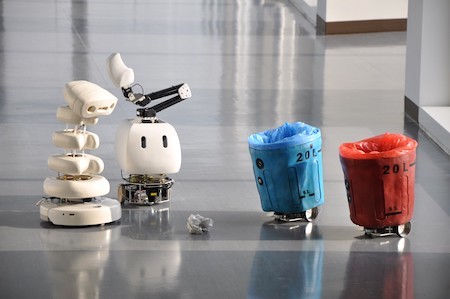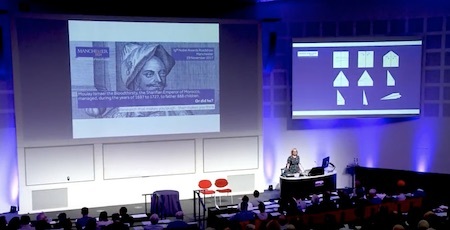Marc Abrahams's Blog, page 164
December 4, 2018
Clicker Training for Surgeons and Other Animals, and other surprises about surgeons
A medical report about using clickers to train surgeons (rather than other kinds of animals) is one of several studies featured in the article “Surprises About Surgeons,” which is one of the articles in the special Medical Surprises issue of the Annals of Improbable Research, which is one of the 143 issues published so far!
Subscribe to the magazine, and a new batch of fresh-cooked improbable research will come your way every two months! A subscription also makes a lovely gift, for certain personality types, we are told.

December 3, 2018
Breathing: A Sigh of Relief (medical report)
A cough led to a cast—a bronchial cast—for (or rather from) the patient described in this medical report.
“Cast of the Right Bronchial Tree,” Gavitt A. Woodard and Georg M. Wieselthaler, New England Journal of Medicine, vol. 379, November 29, 2018, p. 2151. (Thanks to Emily Willingham for bringing this to our attention.) The authors, at the University of California, San Francisco, explain:
“A 36-year-old man was admitted to the intensive care unit with an acute exacerbation of chronic heart failure. His medical history included heart failure with an ejection fraction of 20%, bioprosthetic aortic-valve replacement for bicuspid aortic stenosis, endovascular stenting of an aortic aneurysm, and placement of a permanent pacemaker for complete heart block. An Impella ventricular assist device was placed for management of acute heart failure, and a continuous heparin infusion was initiated for systemic anticoagulation. During the next week, the patient had episodes of small-volume hemoptysis, increasing respiratory distress, and increasing use of supplemental oxygen (up to 20 liters delivered through a high-flow nasal cannula). During an extreme bout of coughing, the patient spontaneously expectorated an intact cast of the right bronchial tree.”

Why don’t ice skaters get swollen hands? An hypothesis
If you were to take part in a prolonged inline roller-skate street journey involving the rhythmic swaying and waving of your outstretched arms in a circular arc, you might end up suffering from oedema (a.k.a. edema). As did Doctor Sody Naimer [pictured] of the Department of Emergency Medicine, Neve Dekalim, Goosh Katif, and Ben-Gurion University of the Negev, Israel. 
Leading the doctor to wonder, en passant, why ice skaters – who are also prone to a lot of arm rotation – don’t as a rule seem to get oedema as a result. His hypothesis is :
“Possible reasons why this problem does not occur during ice skating are the fact that long distances without any stops are uncommon and the cold environment may provide protection through peripheral vasoconstriction.”
See: Centripetal skater’s manual oedema, British Journal of Sports Medicine, vol 36, issue 4.

December 2, 2018
“This question may be found in the weak chicken robot”
“The imagination in the Japanese head is really infinite. The Japanese have won awards for 12 consecutive years from the Ig Nobel Prize, which was founded in 1991. They are also the largest winners after the United Kingdom and the United States. The country, why is it that in such a seemingly orderly and somewhat boring nationality, how can these Japanese people have such ‘abnormal’ thoughts? This question may be found in the weak chicken robot made by a university professor….”
Joel Fukuzawa writes this, and related thoughts, in an article in Medium.

November 30, 2018
Dickey’s gander at a quibble about pitch: 432 Hz for orchestras?
Colin Dicky takes a gander at a cocked quibble, in the essay “Pitch Battles—HOW A PARANOID FRINGE GROUP MADE MUSICAL TUNING AN INTERNATIONAL ISSUE“:
 “In 1988, more than a dozen of opera’s greatest superstars—including Plácido Domingo, Luciano Pavarotti, and Birgit Nilsson [pictured here]—added their names to a petition before the Italian government, asking it to lower the standard pitch at which all orchestras are tuned. At the time, international standard pitch was set at 440 Hz, which is to say that the A above middle C should be tuned to resonate at 440 cycles per second. The petition asked the government to lower this to 432 Hz, claiming that “the continual raising of pitch for orchestras provokes serious damage to singers, who are forced to adapt to different tunings from one concert hall or opera to the next,” and that “the high standard pitch is one of the main reasons for the crisis in singing, that has given rise to ‘hybrid’ voices unable to perform the repertoire assigned to them….”
“In 1988, more than a dozen of opera’s greatest superstars—including Plácido Domingo, Luciano Pavarotti, and Birgit Nilsson [pictured here]—added their names to a petition before the Italian government, asking it to lower the standard pitch at which all orchestras are tuned. At the time, international standard pitch was set at 440 Hz, which is to say that the A above middle C should be tuned to resonate at 440 cycles per second. The petition asked the government to lower this to 432 Hz, claiming that “the continual raising of pitch for orchestras provokes serious damage to singers, who are forced to adapt to different tunings from one concert hall or opera to the next,” and that “the high standard pitch is one of the main reasons for the crisis in singing, that has given rise to ‘hybrid’ voices unable to perform the repertoire assigned to them….”
Here’s more detail (from the Schiller Institute) about the petition, with added commentary that says:
 “This campaign had been originally inspired by Lyndon H. LaRouche, Jr. [pictured here], whose collaborators uncovered the historical evidence that Giuseppe Verdi, Italy’s great composer and nation-builder, had successfully battled to impose a diapason of A=432, based on Middle C=256, as the official tuning of the Italian armed forces in 1884.”
“This campaign had been originally inspired by Lyndon H. LaRouche, Jr. [pictured here], whose collaborators uncovered the historical evidence that Giuseppe Verdi, Italy’s great composer and nation-builder, had successfully battled to impose a diapason of A=432, based on Middle C=256, as the official tuning of the Italian armed forces in 1884.”
Here’s a video that’s mostly audio, of an orchestra tuning up—trying to become in pitch. See if you can hear what pitch—exactly what pitch—they are trying to attain:

A news dump, about taking a dump: The Stool Stool
Alex Blasdel, writing in The Guardian, waxes eloquent about methods old and new: “Bowel movement: the push to change the way you poo— Are you sitting comfortably? Many people are not – and they insist that the way we’ve been going to the toilet is all wrong.” Blasdel describes in depth the commercial rise of a simple product:
The Squatty Potty is a wildly popular seven-inch-high plastic stool, designed by a devout Mormon and her son, which curves around the base of your loo. By propping your feet on it while you crap, you raise your knees above your hips. From this semi-squat position, the centuries-old seated toilet is transformed into something more primordial, like a hole in the ground.
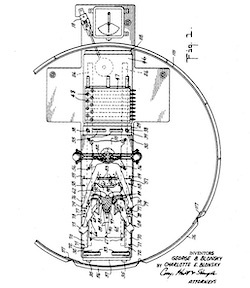
The Blonsky centrifugal birthing device
The family that makes the Squatty Potty says this posture unfurls your colon and gives your faecal matter a clear run from your gut to the bowl, reducing bloating, constipation and the straining that causes haemorrhoids.
The logic behind this invention—the inventor named it the “Squatty Potty”, but let’s call it “the Stool Stool”—is reminiscent of the logic that led to the Blonsky centrifugal birthing device. The idea, in each case, is that:
ancient people learned a biologically-best way; but, but, butt…
civilized, modern people have forgotten what works optimally, and now do things unnaturally.
Blasdel’s essay celebrates not only the stool stool, but especially the video ad that popularized the product:
BONUS (only tangentially related): The power of a name: Dr. Shit Fun Chew. Related to this is what may be the quintessential Twitter tweet.
BONUS (not even tangentially related): The four-legged Periodic Table Table

November 29, 2018
Who ‘owns’ a human placenta?
You might think that, in the eyes of the law, you ‘own’ your body and all its constituent parts. Think again.
“Most women would be stunned to discover that the law does not consider a piece of their body to be their property”
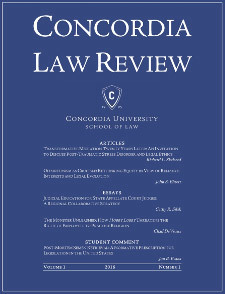 That’s when the body part under consideration is a placenta. This perplexing situation is examined in detail in a new paper by Amber Goeden of the Concordia University School of Law, Idaho, US, who points out, in an article for Concordia Law Review, that :
That’s when the body part under consideration is a placenta. This perplexing situation is examined in detail in a new paper by Amber Goeden of the Concordia University School of Law, Idaho, US, who points out, in an article for Concordia Law Review, that :
“Through the ages, the placenta has been used for many cultural practices, including placentophagy. With an interest in the medicinal benefits of placentophagy, there is a renewed interest in the practice, which has increased the requests for the placenta after birth. This has created an inconsistency in hospital procedures, either requiring women to obtain court orders to receive their placentas or forcing a physician to choose to bypass hospital regulations and give it directly to the patient.“
There are currently only three US states where the situation has been properly clarified (in the remaining ones, the position is currently ‘undefined’.)
“Texas, Oregon, and Hawaii have already recognized a woman’s interest in her placenta. Each state has created statutory requirements, which, once met, allow a woman to take her placenta home. While these states agree that a woman should have access to her placenta, statutes vary between the states.“
See : Concordia Law Review, Volume 3 Number 1, 2018, Article 6, ‘Placentophagy: A Women’s Right to Her Placenta’
Note : The article specifically addresses the current legal situation in the US. In other countries the applicable laws might vary considerably. If you have any documented info. on the legal status in other countries, please do let us know.
BONUS assignment [optional] : If a ‘body part’ is voluntarily discarded by its previous owner – for example hair in a hair salon, or a decayed tooth at the dentist’s, does its ‘ownership’ change? If so when?

November 28, 2018
The Man Who Was and Was Not Freddie Mercury—and other surprises about patients
A psychiatric report about “a patient who was a double for and imitator of the late Freddy Mercury, lead singer for the rock group Queen” is one of several studies featured in the article “Surprises About Patients,” which is one of the articles in the special Medical Surprises issue of the Annals of Improbable Research, which is one of the 143 issues published so far!
Subscribe to the magazine, and a new batch of fresh-cooked improbable research will come your way every two months! A subscription also makes a lovely gift, for certain personality types, we are told.

A look back at an Ig Nobel night in Manchester
Here’s a look back at the Ig Nobel show at the University of Manchester, two years ago. Usually when we do events in the UK, they are in the springtime, part of the annual Ig Nobel EuroTour. This was a special show in late autumn, 2017.
This was in Lecture Theatre B, University Place, on Oxford Road — featuring:
Marc Abrahams , founder of the Ig Nobel Prize ceremony
Elizabeth Oberzaucher (Ig Nobel Prize winner—biological likelihood that the emperor of Morocco fathered 800 sons)
Tom Williamson (creator of the web site WisdomofChopra, which contributed to the Ig Nobel Prize winning study “On the reception and detection of pseudo-profound bullshit“)
Andre Geim (Ig Nobel Prize winner —using magnets to levitate a frog)
Kees Moeliker (Ig Nobel Prize winner—homosexual necrophilia in the mallard duck).
The event was free of charge, and included refreshments and a drinks reception. Paper airplanes were not discouraged. Special thanks to Dame Nancy Rothwell for making this evening happen.

November 27, 2018
Two tales of headphone jacks gone awry
Two reports about headphone jacks, appearing in the same year, raise possibilities. Here are portions of the two reports, side by side:
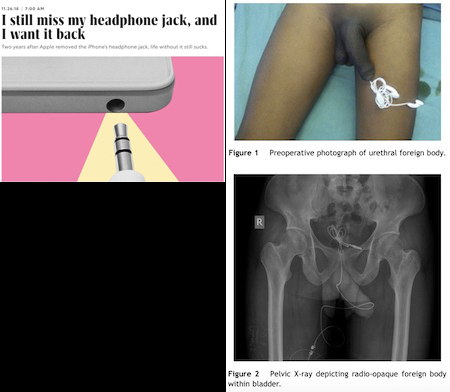
Mark Wilson writes, in Fast Company magazine:
I still miss my headphone jack, and I want it back
Two years after Apple removed the iPhone’s headphone jack, life without it still sucks….
The Asian Journal of Urology reports:
“Listening to his inner voice? An unusual urethral foreign body: A review of literature and few learning points,” Abheesh Varma Hegde, Suryakanth Choubey, Revanna Siddappa Kanagali, Gotam Pipara, A. Nagaraja Rao, and A. Mohan, Asian Journal of Urology, vol. 5, no. 2, April 2018, pp. 131-132. (Thanks to Richard Wassersug for bringing this to our attention.) The authors, at St. Johns Medical College Hospital, Bangalore, India, report:
“A 26-year-old man presented to the Emergency Department with dysuria and urinary retention. There were no other urinary symptoms. History revealed he had self-inserted the jack of an ear phone into his penis 2 h prior, for autoerotic stimulation. There were three prior instances of such insertions after which he would remove the ear phones himself. He had also tried to catheterize himself in the past, for sexual gratification. There was no history of underlying psychiatric illness. On examination, the ear phones and the cable were dangling from the external urethral meatus and the cable was palpable within the penile urethra (Fig. 1). Pelvic radiography showed a variable length of the cable within the bladder that appeared to be coiled and the ear phone jack, intact (Fig. 2).”
BONUS (distantly, if at all, related): Plug and Play
BONUS (probably unrelated): “A Salute To Head-Scratching Science”

Marc Abrahams's Blog
- Marc Abrahams's profile
- 14 followers





